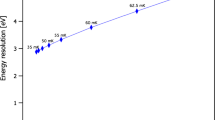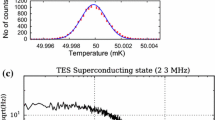Abstract
A transition-edge-sensor (TES) microcalorimeter’s shunt resistor (R sh) and thermal conductance to the cryogenic bath (G) are often considered to be interchangeable knobs with which to control detector speed. Indeed, for otherwise-identical TES-parameter models, there are many combinations of R sh and G that give the same decay time-constant (τ crit). However, our previous work showed that with time- or code-division-multiplexed readout, the distribution of signal-to-noise ratio with frequency, which depends strongly on R sh and G, is just as important as τ crit. Here, we present a set of calculations to select the optimal values of R sh and G, given a linear TES model and count-rate and energy-resolution requirements. Lower G and lower R sh make multiplexing easier. Our calculations also determine the allowed combination of SQUID-readout noise (S Φ ) and multiplexer row-period (t row) and row-count (N rows). Recent improvements to S Φ and t row in the NIST time-division-multiplexing architecture have allowed a NIST eight-pixel TES array to be read out with 2.70 eV (full-width at half-maximum) average energy resolution at 6 keV. The improvements make the X-ray Microcalorimeter Spectrometer co-proposed by NASA and NIST for ESA’s Athena X-ray observatory straightforwardly achievable, including engineering margin, with N rows=16.




Similar content being viewed by others
References
C.A. Kilbourne et al., SPIE Conf. Ser. 7011, 701104 (2008)
N. Iyomoto et al., Appl. Phys. Lett. 92, 013508 (2007)
K.D. Irwin, G.C. Hilton, in Cryogenic Particle Detection, ed. by C. Enss (Springer, Berlin, 2005)
W.B. Doriese et al., AIP Conf. Proc. 1185, 450–453 (2009)
A.E. Szymkowiak et al., J. Low Temp. Phys. 93, 281–285 (1993)
R.H. den Hartog et al., IEEE Trans. Appl. Supercond. 21(3), 289–293 (2011)
W.B. Doriese et al., Nucl. Instrum. Methods Phys. Res., Ser. A 559, 808–810 (2006)
K.D. Irwin et al., Supercond. Sci. Technol. 23, 034004 (2010)
J.W. Fowler et al., J. Low Temp. Phys. (2012). doi:10.1007/s10909-012-0463-4
Acknowledgements
NIST and NASA/GSFC are jointly performing technology demonstrations for the Athena XMS instrument. We thank Caroline Kilbourne, Rich Kelley, Simon Bandler, Scott Porter, and the rest of the NASA group for useful discussions. Publication of an agency of the United States Government; not subject to copyright.
Author information
Authors and Affiliations
Corresponding author
Rights and permissions
About this article
Cite this article
Doriese, W.B., Alpert, B.K., Fowler, J.W. et al. Optimization of the TES-Bias Circuit for a Multiplexed Microcalorimeter Array. J Low Temp Phys 167, 595–601 (2012). https://doi.org/10.1007/s10909-012-0509-7
Received:
Accepted:
Published:
Issue Date:
DOI: https://doi.org/10.1007/s10909-012-0509-7




